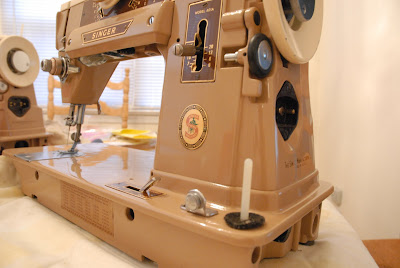My story starts when my wife decided she wanted a new sewing machine (first time) Growing up, my mother was a seamstress for as long as I can remeber. She started with a Singer 316g that my grandpa bought her when she was a teenager. When I was about 8 years old, she was already sewing stuff for us kids and for other people in town that she knew and not long before I was nine she had purchased a used industrial straight stitch pfaff machine and later a brand new llamato overlock machine and very soon a bunch of customers that would come to our house for her to make all sorts of garments for them. She used the dining room table to cut the patterns and a small room to sew where she was able to arrange to fit all three machines, shelves for threads and piles of "Burda" (a german magazine like with the newest fashions and patterns)
Any-who, back to my wife and the machine she wanted, Singer has been a symbol of quality for decades, but in my opinion the new machines are just not in any way shape or form comparable to the old ones as far as quality and durability. Ease of use maybe but that's just about it.
After a few discussions she finally agreed to let me look for an older metal machine so I started searching for one. One night a few months back, arranging things for a garage sale at our church, she noticed a funky looking box that was laying under a table and she looked at me and say "did you see that? is a singer sewing machine" (the bos had a logo on it. It looked like a suitcase from a James Bond movie. She grabbed it and opened it and out came this brand new looking all metal singer sewing machine that was heavy as it was sturdy. How much? I asked the lady in charge and she looked at it and said Is twenty dollars ok? and we looked at each other and said "sold"
It came with no attachments or foot controller, just the machine and the case but my wife -the same wife that felt insulted every time I brought up the subject about buying a nice older sewing machine instead of a new one- was happy as a six year old on Christmas eve.
Brought it home and started looking for accessories on e bay and craigs list and the more we looked at it the more amazed we were with the condition of it. It looked in an out as though someone had bought it in the fifties, used it once or twice and then put it in the attic until 2009. That's when I was bit by the bug. As I looked for information on the 403, I found out about the 401A and what it did and I was just bedazzled by it's looks and the feed back I read from it. So I made it my personal project to find a nice 401 in decent shape and cheap, because I did not feel like spending a $300 to $400 for a sewing machine I didn't need.
So I finally got a 401A for $65, the owner originally wanted $120 but I was able to get her to sell it for $65 because the built in stitch dials were frozen and it was in very poor mechanic and cosmetic condition... or so I thought. As it sat there it could only do straight stitch and had no attachments, only the original baquelite button foot controller.
I drove 45 miles back and forth and got nothing much but a sour look from my wife and a feeling in my gut that I had been taking.
The next day I got up and put the machine on the dinning room table, gathered some tools, rags and my always faithful friend WD40 and got to work.
First of I removed the top and side door to expose the truth about the gears and shafts. To my surprise, aside from the amount of grime, dried up oil film and lint (there was enough to make myself a nice fleece for the winter) all gears and everything else seemed to be fine. So I went on and removed the front badges and thread guides as well as the light cover and socket so I could degrease, clean and make everything look as good as I could, unfortunately I was not thoughtful enough to take a picture before starting to dismantle and clean it.

This is after the first round with wd40
Cleaned and vacuum every hole where there was any lint and dust and then cleaned with wd40 and a rag to remove as much grime and oil film from the enamel
Disassembled the knobs and dials to clean and free up. The built in stitch badge and white dial stayed since I was able to free up the stitch patter mechanism by cleaning, oiling and adjusting .
HERE IS AN EXAMPLE OF THE BEFORE AND THE AFTER
AFTER SPRAYING AND CLEANING
PULLED WIRE OUT, CLEANED CHECKED AND PUT BACK ON
TOOK MY TIME AND CLEANED EVERY CORNER
UNTIL IT LOOKED NEW AGAIN
THIS KNOB WAS CLEAND IN PLACE SO I DID NOT HAVE TO TAKE THE SHAFT APPART, BUT I WAS STILL ABLE TO CLEAN BOTH KNOBS AND POLISH THEM
PAYED ATTENTION TO EVERY DETAIL... EVEN THE SCREWS AND BOLTS WERE CLEANED
MY WIFE CLEANED THE CASE BEFORE I COULD TAKE A PICTURE OF THE "BEFORE" BUT I ASSURE YOU IT WAS SO DIRTY AND STAINED I THOUGHT I WAS GOING TO THROW IT OUT
ONCE THOROUGHLY CLEANED I PROCEEDED TO OIL IT
I did the same thing underneath, but didn't want to bore you with the same . Once cleaned and oiled inside, I polished all the badges and the enamel on the core to the last corner. Then Put it back together and waxed it.
LOOK AT THE ENAMEL SHINE. THE COAT IS ALMOST A SIXTEENTH OF AN INCH THICK
BACK TOGETHER, MOST OF THE LITTLE SCRATCHES AND WHAT I TOUGHT WERE PERMANENT STAINS OR NICKS ARE GONE!!!
IT TRULLY LOOKS LIKE A NEW MACHINE AND IT WORKS BETTER THAN A NEW PLASTIC ONE, IN EVERY STICH PATTERN AND SIZE
AND HERE THE ARE BOTH TOGETHER, OUR 401A AND OUR 403, BOTH LOOK AND WORK LIKE A MILLION DOLLARS AND WE DIDN'T HAVE TO TAKE THEM IN FOR SERVICE. I TRULLY HOPE YOU ENJOYED THIS BLOG AND PLEASE, IF YOU HAVE ANYTHING TO SHARE WITH US REGARDING ANY OF THESE TWO MODELS DO SO.
THANK YOU FOR STOPPING BY AND GOD BLESS YOU ALWAYS


























I have 3 401A's. I learned to sew on my mother's machine she purchased new when I was very little. I loved it so much, I wanted one for my own when I got married. By a miracle, my mother and dad found a "used" one for me. It was in mint condition, and I have used it for 40+ years. I found one at the Goodwill sometime back, that I bought for my daughter in law. And then, when my mother passed away, I inherited hers. They are truly great machines! I enjoyed your article and hope your wife is still enjoying hers!.
ReplyDeleteHello - can I ask what product you used to polish and wax the exterior enamel with? I just purchased one and am looking to do the same - yours looks fantastic!!!
ReplyDeleteI just purchased one however I wonder if they will sew denim. love your article
ReplyDeleteMake sure that you use a large needle meant for denim.
DeleteHello,
ReplyDeleteThank you for your article. I have a 401 A and a foot pedal, but not the power cord. Do you know what parts are needed to power the sewing machine with a foot pedal? It looks as if the power cord has a three prong attachment to plug into the sewing machine, but I don't see what connects that to the foot pedal, which has a two prong attachment. How do they get put together and what parts do I look for on the internet? Any info would be appreciated. Thanks, ak
My husband bought me a 401A in 1961, and I loved that machine. Nothing since has been as well-used or as well-made. Hated when Singer went downhill.
ReplyDeleteI was able to purchase a Singer 431G (this is like the 411G but w/an open arm) but one of the spool pins got broke during shipping and a thread guide on the top left front was missing. I was able to purchase a replacement from a fellow sewer in England. Love the idea of it having an open arm and am itching to get around to her clean up and running.
ReplyDeleteThe 401 is a fabulous machine and you did a beautiful job restoring it. You mentioned that vintage Singers were built in the USA the old-fashioned way, but keep in mind that a great many of them were built overseas as well - in Scotland, France, Germany, and Italy to name a few places. But they were indeed well-engineered and built to last a lifetime.
ReplyDelete